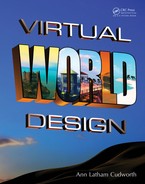
152 Virtual World Design
color “PSYS_PART_END_COLOR” to match the color of the sphere. For instance, in the bright red sphere,
this change will generate particles that start white and end up bright red.
Remember in the color menu of Firestorm that there is a converter, so you can change the RGB values into the
percentages that the LSL particle script code needs, and they give a handy button that will copy these values to
your clipboard, so you can paste the numbers into your script in place of the number that is already there. The red
sphere code line would read PSYS_PART_START_COLOR, <1,1,1>, PSYS_ PART_END_COLOR, <1,0,0>.
The nal thing to do in this section is to link these elements together and move them into the Sensory Space.
To do this, select all the planets rst, holding the Shift key down so they are selected collectively, and then select
the cylinder as shown in Figure 7.9. Pick the Link button on the Build/Edit top menu. The planets should have blue
halos, and the cylinder will have a yellow halo, indicating that they are linked and the cylinder is the keyprim.
If you have more questions or need a more detailed description about linking prims, that is available
online (http://community.secondlife.com/t5/English-Knowledge-Base/Build-Tools/ta-p/700039).
You are in the home stretch! Take this linked structure into your inventory as a backup. Rez a copy on the
ground near the front door of the Sensory Space and move it into the center of the inner space. Orient the
cylinder around the center column of the Sensory Space, and when it’s set, change the texture on just that part
into a 100% transparency, so it disappears. You will see the light sources from the spheres affect the internal
walls of the space immediately, especially if you have your graphics levels set up in High or Ultra.
Figure7.10 is a view of this setup of the planetary system inside the Sensory Space model. For even
greater visual effects, you can do these two additional things: (1) add a spin script into the cylinder to make
the whole particle/planetary system rotate around the center column and (2) turn on the advanced lighting
(sun, moon, and projectors) and change the lights into projectors that use the Galaxy_gobo_black texture to
project a star image on the surrounding surfaces. This additional texture is included in the Chapter 7 content.
FIGURE 7.8 Screen grab showing the creation of sphere prims around the cylinder for the particle “planetary system.”

153Color, Particles, andSensory Spaces
FIGURE 7.10 Screen grab showing installation of particle-emitting, light source prims in the Sensory Space.
FIGURE 7.9 Screen grab showing result of making the particle emitting prims into light sources, coloring their
texture, and linking them to the central cylinder.
154 Virtual World Design
7.8 CONCLUSIONS ABOUT COLOR
Colors and particle systems are two of the most magical elements in a virtual environment. Both add dyna-
mism and depth to the visitors’ experience in a virtual space. Both can be used to support and enhance the
impact of your client’s message. Becoming a “power user” with color and particles is one of the perks of
being a designer. Enjoy it.
REFERENCES
1. Particle System, Wikipedia article, http://en.wikipedia.org/wiki/Particle_system. Accessed April 7, 2013.
2. Young-Helmholtz Theory, Wikipedia article, http://en.wikipedia.org/wiki/Young%E2%80%93Helmholtz_theory.
Accessed April 5, 2013.
3. Linguistic Relativity and the Color Naming Debate, Wikipedia article, http://en.wikipedia.org/wiki/Linguistic_
relativity_and_the_color_naming_debate. Accessed April 22, 2013.
4. MacEvoy, Do Primary Colors Exist? Color Vision blog, http://www.handprint.com/HP/WCL/color6.html#
materialtrichromacy. Accessed April 17, 2013.
5. Subtractive Color, Wikipedia article, http://en.wikipedia.org/wiki/Subtractive_color. Accessed April 7, 2013.
6. Tertiary Color, Wikipedia article, http://en.wikipedia.org/wiki/Tertiary_color. Accessed April 7, 2013.
7. Global Illumination Wikipedia article, http://en.wikipedia.org/wiki/Global_illumination. Accessed April 7, 2013.
8. Khouw, Natilia, Gender Differences—The Meaning of Color for Gender, Color Matters, http://www.colormatters.
com/color-symbolism/gender-differences. Accessed April 15, 2013.
9. Fields, R. Douglas, Why We Prefer Certain Colors, Psychology Today, April 1, 2011, http://www.psychologytoday.
com/blog/the-new-brain/201104/why-we-prefer-certain-colors. Accessed April 13, 2013.
10. Color Vision, Wikipedia article, http://en.wikipedia.org/wiki/Color_vision. Accessed April 15, 2013.
11. Mahnke, Frank H., and Rudolf H. Mahnke, Characteristics and Effects of Major Hues, in Color and Light in
Man-made Environments, Chapter 2, Location 166, 209, 217, 231, 1222, Wiley, New York, 1993.
12. Color Blindness, Wikipedia article, http://en.wikipedia.org/wiki/Color_blindness. Accessed April 20, 2013.
13. Light and Space, Wikipedia article, http://en.wikipedia.org/wiki/Light_and_Space. Accessed June 21, 2013.
..................Content has been hidden....................
You can't read the all page of ebook, please click here login for view all page.
